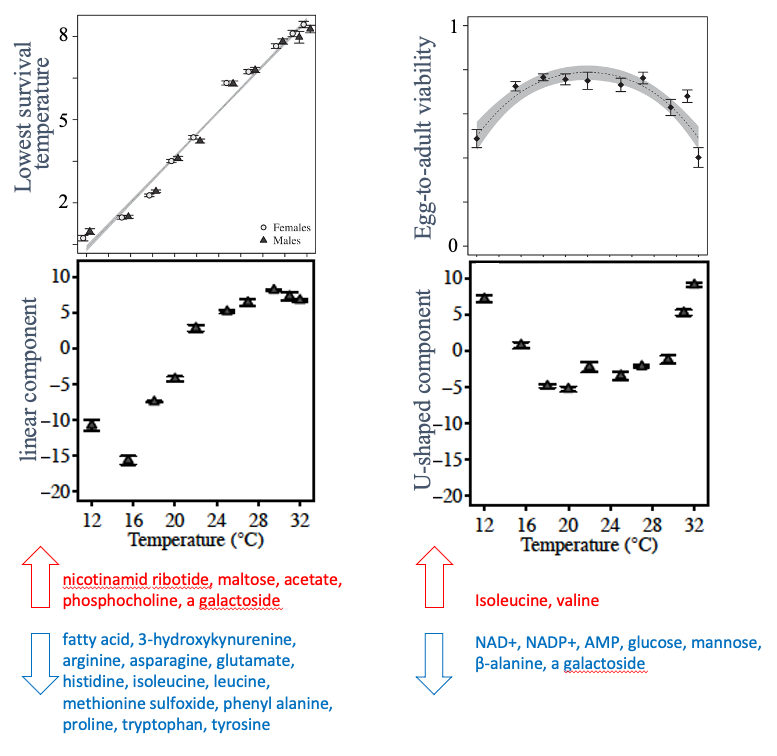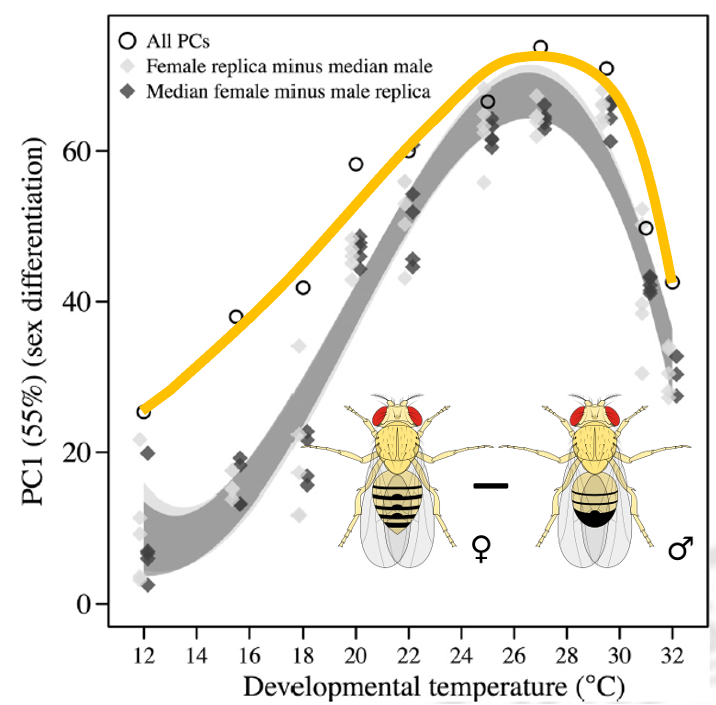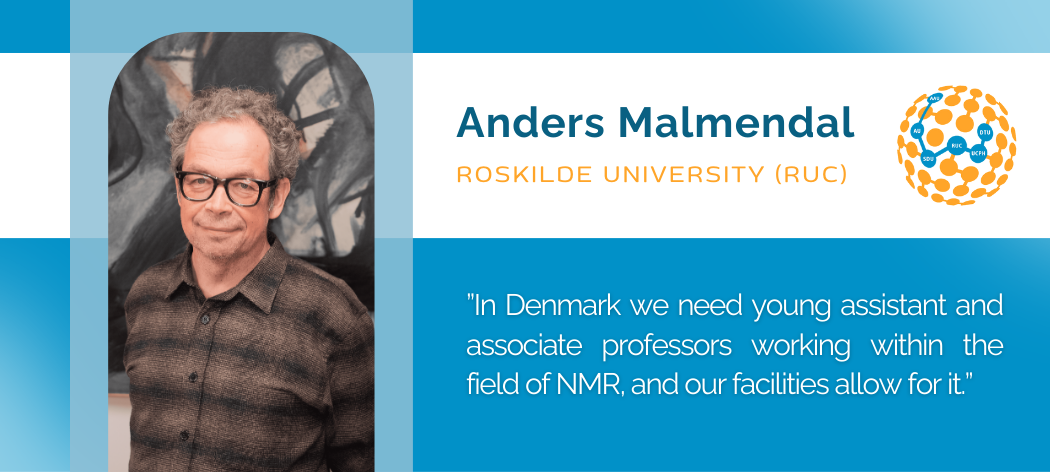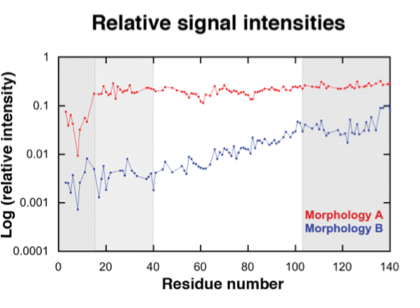Anders Malmendal from Roskilde University (RUC) uses NMR spectroscopy of both small molecules and proteins to better understand neurodegenerative disease and other biological processes and has a preference for fruit flies as model animals.
Anders Malmendal was educated as a chemical engineer at Lund University in Sweden and ENSIGC in Toulouse, France. After finishing his master’s thesis, he stayed in Lund to write his PhD in biophysical chemistry. Here, he used NMR to get both structural and dynamic information on how calcium-binding proteins bind calcium cooperatively. Anders has worked with different shades of NMR ever since.
After a Post doc at Scripps Research Institute and Vanderbilt University in the US, he decided to return to Scandinavia to work with Niels Chr. Nielsen at Aarhus University (AU). Here he had his first acquaintance with amyloid forming proteins which he found very fascinating. He also collaborated with a group of talented young geneticists led by Volker Loeschcke, who wanted to do metabolomics, i.e. measure the concentrations of all measure small molecules—metabolites—in fruit flies that were subjected to different stresses. Even if Anders thought it was a terrible to run NMR on mashed fruit flies, it turned out to be a very powerful method, and they published the first ever fruit flies metabolomics paper. Anders has published a lot of fruit fly metabolomics papers since.
Fruit flies are good animal models since they are surprisingly like humans, with many of the biochemical processes being the same or similar, but the flies are cheaper, easier to handle, have shorter generation times, and so on than both humans and the rat and mice that are commonly used. This means that you can measure the effects of many more parameters or make experiments that would otherwise be impossible.
Other advantages of fruit flies are that they are extremely well-studied and easy to get. In fact, there are fruit fly libraries, where you can order almost any type of fruit flies you need for your studies.
How fruit flies survive the harsh climates
In one of Anders’ fruit fly research projects, they observed the fly’s development from egg to adulthood. They exposed the flies to the full range of environmental temperatures where the flies can survive and measured all metabolites: amino acids, sugar, and other water-soluble compounds.
They observed that some of the metabolites changed almost linearly with environmental temperature, meaning they were sparse at low temperatures and abundant at high temperatures or vice versa, and that some metabolites, had a U-shaped temperature profile where the concentration changed in the same direction when going from room temperature to cold and hot. The first set of metabolites could be seen as directly related to temperature, while the latter could be seen as a kind of general temperature stress response.
They also investigated the difference between male and female fruit flies and observed the largest difference at room temperature. An interpretation of this could be that at the more stressful temperatures, they needed to focus on survival and didn’t have the luxury to express all their sex-orientated features. Though humans, in contrast to fruit flies, are wired to keep a constant temperature, sex differences may still be suppressed in stressful environments.

doi: 10.1152/ajpregu.00268.2016

doi: 10.1152/ajpregu.00268.2016
The cause of neurodegenerative diseases
After many years at AU, Anders moved to the Institute of Biomedical Sciences at the University of Copenhagen (UCPH) to do metabolomics in a truly medical setting, but it wasn’t that easy:
“It was a large cultural shift, and for me as a biophysical chemist it was surprisingly hard to communicate with the medical scientists .” Anders says.
After working with metabolomics only for many years Anders got the opportunity to work with NMR on amyloid-forming proteins together with his old friends and colleagues from Lund, Sara Linse and Mikael Akke. This is where he really started to use NMR and other techniques to understand the mechanisms behind amyloid fibril formation in different neurodegenerative diseases such as Alzheimer’s, Parkinson’s and Amyotrophic lateral sclerosis (ALS).
“These neurodegenerative diseases occur because of proteins like amyloid b in Alzheimer’s and a-synuclein in Parkinson’s, form oligomers, aggregates of around 2-10 proteins, that may turn into amyloid fibrils, which in turn may catalyze the formation of new fibrils.” Anders elaborates.
Proteins can exist in many different forms where some form oligomeric structures that, through a nucleation process, can initiate the formation of long amyloid fibrils, which is the material found in plaques in neurological diseases. Proteins can then bind on the side of the fibril, which catalyzes the formation of new fibrils, a process called secondary nucleation. This process then creates more fibrils in a cascade accumulating fibrils in the body. It is not the fibril that is the problem in neurodegenerative diseases, but some oligomers that are formed in this process and are toxic to nerve cells. Mutations or post-translational modifications can change the relative stability of different protein conformations, thus affecting the propensity to form oligomers and fibrils and or the type of fibrils formed.
“We have learned so much about protein aggregation in recent years, but there is so much more to learn. We use NMR-spectroscopy to understand more about these processes. One of the great strengths of NMR spectroscopy in this field of study is that you can high-resolution information about the interactions involved in protein aggregation.” Anders explains.
Residue-resolved signal intensities of alpha-synuclein monomers in the presence of two different fibril morphologies. The intensities are measured relative to the intensities in the same solution before the formation of any fibrils. These data show that the free concentration of alpha-synuclein monomers is different for the two morphologies and that the different parts of the protein monomers interact differently with the two morphologies.
NMR at Roskilde University
In 2019 Anders moved to RUC, where he is the only full-time scientist focused entirely on NMR, although Poul Erik Hansen, who is now retired but has pioneered NMR at RUC is still very active. At RUC, Anders continues working with interactions of amyloid proteins and with metabolomics.
Research collaboration
Anders is working at the Department of Science and Environment where all the natural science research at RUC takes place. While it may sometimes be a disadvantage to be small, one great advantage is that very different scientists are working at the same department and sometimes in the same building making it easier to collaborate with scientists in other fields, compared to larger institutions.
”It is very easy to find collaborators in other fields of natural science here at RUC since we are all in the same department.” Anders says.
Anders collaborates with scientists at all other universities in Denmark and with medical doctors at Danish hospitals. Among different European collaborations, the Swedish connection is strong. He still has an intense collaboration with Lund University and sends most of his large metabolomics sample sets to the Swedish NMR Center in Gothenburg where they have robotic systems for automatic handling and NMR measurements of large sets of samples.
A recent interest is the use of NMR metabolomics for the optimization of industrial fermentation processes. In a project funded by the European Union’s regional funds through BioSolutions Zealand, Anders has, together with the startup companies atSpiro and Sundew, investigated how NMR can be used to optimize a fermentation reaction where a lipopeptide that can be used to control parasites in aquaculture is produced. The project has shown how NMR can keep track of all the different nutrients and byproducts and provide information on how we can optimize the process, both in general and in the individual batch.
Strength of Danish NMR
”DANNMR’s consists of a bunch of people working with a wide range of NMR applications that get along well and know each other well.” Anders says of the Danish NMR society.
“It is easy to get access to high field NMR spectrometers at the National centers at DTU and Aarhus University when needed”, he explains.
”In Denmark we need young assistant and associate professors working within the field of NMR.” Anders emphasizes as an important aspect for the future of DANNMR.
Written by: Jonatan Emil Svendsen


